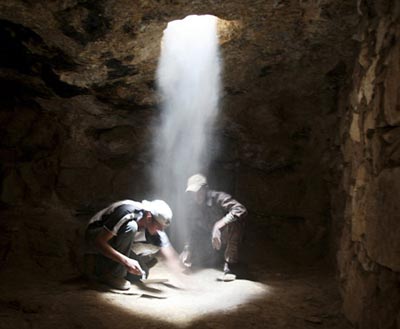The oldest church: the discovery is still controversial
A recent announcement by a Jordanian archaeologist that he has just discovered the world's first Christian church in an underground cave surprised and disagreed with experts in Jordan and beyond. gender.
The Jordan Times quoted archaeologist Abdel-Qader al-Housan, director of the Rihab Archaeological Research Center, as follows: 'We have discovered a project that we believe is the first church on. the world, dating from 33 to 70 AD. '
Al-Housan then told the Associated Press that he discovered a cave beneath St. Church. George, one of the oldest known churches in the world of Rihab in northern Jordan, and that cave contains evidence of early Christian rituals.
Archaeologist said he discovered a circular church area inside the cave with stone seats separate from a residential area with a tunnel leading to water.
Ghazi Bisheh, former Minister of Archeology of Jordan, dismissed the claim and called it 'silly', saying that the archaeologist behind this discovery 'tends to exacerbate discovery' and do not give evidence to prove their recent evaluation.
There are countless natural caves in Rihab and dozens of churches, but most of them date from the 6th or 7th century. Bisheh believes that, based on the style of mosaic Basilica, St. Church. George belongs to this period. But Al-Housan and others believe that the Church of St. George has since 230 AD.

(Photo: Ali Jarekji / Reuters)
Early churches
According to Al-Housan, the mosaic on the church floor is a Greek carvings meaning '70 people favored by God and gods'. He believes it refers to the 70 apostles who fled the abuse of the Roman army in Jerusalem in the 1st century AD, after the death of Jesus. According to Al-Housan, these apostles built a church in a cave and used it as a place of worship.
While the first Christian followers actually fled the Roman military loot in Jerusalem in 70 AD, ie, today's Jordan, Bishes said the identity of the apostle in an unknown mosaic obviously.
Scholars believe that organized churches did not exist until at least the 3rd century AD. After the death of Jesus, Christian worship rituals usually take place only in houses or other residential buildings, or less common than on rivers outside the city wall during the first century. Public. Architecturally organized and different churches did not appear until the Byzantine period, 5th century AD.
Early Christian churches will include a chanting area - semi-circular areas in the temple facing the East - similar to the synagogue, towards Jerusalem.
The suspicion of experts
Bible researcher Stephen Pfann, president of the University of Holy Land in Jerusalem, reacts cautiously to Al-Housan's findings.
'It seems they are wrong. In the 1st century, the term 'church' or 'ekklsia' was used to refer to a group of believers - not a building or a grave they gathered. If they were talking about a cave, it was probably a hiding place.
If there are martyrs there or an important event taking place or a famous among the apostles of Jesus - then you will have a reason to commemorate this area, where later monks will be of the church used.
But with this cave, this is not necessarily a memorial place. I don't understand why you could pick up an underground cave and think it might be a 1st century church. '
Pfann said the official, architecturally different type of church that could be viewed began to appear in an excavated area in 2005 in an Israeli prison near Har Megiddo (or 'Armageddon' in Greek and English, meaning the end of the world). Appearing around the 3rd century, it is widely accepted as the oldest church in the world ever discovered.
Archaeologist Yotam Tepper of Israel's Archaeological Community excavated Megiddo prison area.'A Christian chapel or gathering place from the 3rd century is possible. But a church from the 1st century seems really amazing, although I don't know if I can completely eliminate that possibility without seeing archaeological evidence like pottery and coins. I think we have to wait until we find out. '
- Astronaut sculpture in the church since the 12th century - proof of piercing?
- Discovered the oldest Christian church in Israel
- The mysterious church built by 'angels' in Africa
- The church decorated with more than 40,000 skeletons
- 14 oldest ancient artifacts in the world
- The discovery of the site is said to be the oldest pyramid
- Build a human saving church from
- The 400-year-old church surfaced after the drought
- An ancient church in Israel may have been built only a few years after the Muhammed messenger died
- The discovery of the remains resembles the astronomer Copernicus
- Thousands of medieval jewelry were discovered underneath Scandinavian churches
- 10 famous architectural masterpieces through the era
 Discovered an ancient centipede fossil 99 million years old
Discovered an ancient centipede fossil 99 million years old Discovered bat-like dinosaurs in China
Discovered bat-like dinosaurs in China Discovered a 200-year-old bronze cannon of the coast
Discovered a 200-year-old bronze cannon of the coast Discover 305 million-year-old spider fossils
Discover 305 million-year-old spider fossils Coffin suspected to belong to 'Santa Claus' discovered
Coffin suspected to belong to 'Santa Claus' discovered  Church installs AI confession room
Church installs AI confession room  Decipher the piece of 'human skin' on the door of a medieval church
Decipher the piece of 'human skin' on the door of a medieval church  The monstrous leaning church in the world's scariest 'ghost village'
The monstrous leaning church in the world's scariest 'ghost village'  1,500-year-old stone mosaic buried in ash
1,500-year-old stone mosaic buried in ash  An ancient church in Israel may have been built only a few years after the Muhammed messenger died
An ancient church in Israel may have been built only a few years after the Muhammed messenger died 